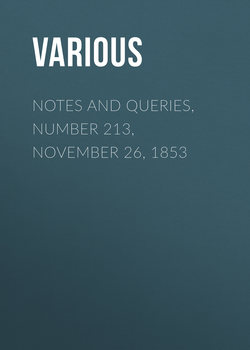Читать книгу Notes and Queries, Number 213, November 26, 1853 - Various - Страница 7
Queries
ОглавлениеGRAMMAR IN RELATION TO LOGIC
Dr. Latham (Outlines of Logic, p. 21., 1847, and English Language, p. 510., 2nd edition) defines the conjunction to be a part of speech that connects propositions, not words. His doctrine is so palpably and demonstrably false, that I am somewhat at a loss to understand how a man of his penetration can be so far deceived by a crotchet as to be blind to the host of examples which point to the direct converse of his doctrine. Let the learned Doctor try to resolve the sentence, All men are either two-legged, one-legged, or no-legged, into three constituent propositions. It cannot be done; either and or are here conjunctions which connect words and not propositions. In the example, John and James carry a basket, it is of course quite plain that the logic of the matter is that John carries one portion of the basket, and James carries the rest. But to identify these two propositions with the first mentioned, is to confound grammar with logic. The former deals with the method of expression, the latter with the method of stating (in thought) and syllogising. To take another example, Charles and Thomas stole all the apples. The fact probably was, that Charles' pockets contained some of the apples, and Thomas' pockets contained all the rest. But the business of grammar in the above sentence is to regulate the form of the expression, not to reason upon the matter expressed. A little thought will soon convince any person accustomed to these subjects that conjunctions always connect words, not propositions. The only work in which I leave seen Dr. Latham's fundamental error exposed, is in Boole's Mathematical Analysis of Logic; the learned author, though he seems unsettled on many matters of logic and metaphysics, has clearly made up his mind on the point now under discussion. He says:
"The proposition, every animal is either rational or irrational, cannot be resolved into, Either every animal is rational, or every animal is irrational. The former belong to pure categoricals, to latter to hypotheticals [Query disjunctives]. In singular propositions such conversions would seem to be allowable. This animal is either rational or irrational, is equivalent to, Either this animal is rational, or it is irrational. This peculiarity of singular propositions would almost justify our ranking them, though truly universals, in a separate class, as Ramus and his followers did."—P. 59.
This certainly seems unanswerable.
If Dr. Latham is a reader of "N. & Q.," I should be glad if he would give his reasons for adhering to his original doctrine in the face of such facts as those I have instanced.
C. Mansfield Ingleby.
Birmingham.
THE CORONET [CROWN] OF LLEWELYN AP GRIFFITH, PRINCE OF WALES
A notice, transferred to The Times of the 5th instant from a recent number of The Builder, on the shrine of Edward the Confessor, after mentioning that "to this shrine Edward I. offered the Scottish regalia and the coronation chair, which is still preserved," adds, "Alphonso, about 1280, offered it the golden coronet of Llewelyn, Prince of Wales, and other jewels."
Who was Alphonso? And would the contributor of the notice favour the readers of "N. & Q." with the authority in extenso for the offering of this coronet?
The period assigned for the offering is certainly too early; Llewelyn ap Griffith, "the last sovereign of one of the most ancient ruling families of Europe" (Hist. of England, by Sir James Mackintosh, vol. ii. p. 254.), having been slain at Builth, Dec. 11, 1282. Warrington (Hist. of. Wales, vol. ii. p. 271.), on the authority of Rymer's Fœdera, vol. ii. p. 224., says: "Upon stripping Llewelyn there were found his Privy Seal; a paper that was filled with dark expressions, and a list of names written in a kind of cypher;" omitting, it will be observed, any reference to Llewelyn's coronet. That monarch's crown was probably obtained and transmitted to Edward I. on the capture, June 21, 1283, or shortly after, of his brother David ap Griffith, Lord of Denbigh, who had assumed the Welsh throne on the demise of Llewelyn; the Princess Catherine, the daughter and heir of the latter, and de jure sovereign Princess of Wales, being then an infant. Warrington states (vol. ii. p. 285.) that when David was taken, a relic, highly venerated by the Princes of Wales, was found upon him, called Crosseneych, supposed to be a part of the real cross brought by St. Neots into Wales from the Holy Land; and he adds that, besides the above relic, which was voluntarily delivered up to Edward by a secretary of the late Prince of Wales, "the crown of the celebrated King Arthur, with many precious jewels, was about this time presented to Edward," citing as his authorities Annales Waverleienses, p. 238.; Rymer's Fœdera, vol. ii. p. 247.
There are some particulars of these relics in the Archæologia Cambrensis; but neither that periodical, nor the authorities referred to by Warrington, are at the moment accessible to me.
Cambro-Briton.
